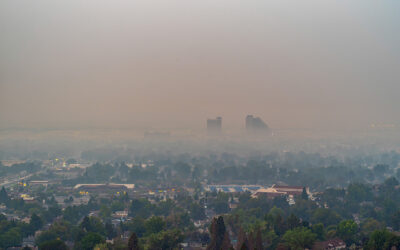Carson City, NV – The Nevada Division of Environmental Protection (NDEP) and Desert Research Institute (DRI) are excited to announce a new partnership program that will expand wildfire smoke air quality monitoring infrastructure and public information resources for rural communities across the state. Funded by a $550,000 grant from the U.S. Environmental Protection Agency (EPA), the new Nevada rural air quality monitoring and messaging program includes installation of approximately 60 smart technology air quality sensors that measure fine particle pollution – the major harmful pollutant in smoke – and additional communications tools to help rural Nevada families near the front lines better understand their risks from wildfire smoke and the steps they can take to protect their health.
“The growing impacts of climate change are being felt in all corners of Nevada, with record-breaking temperatures and extreme drought fueling catastrophic wildfires across the west,” said NDEP Administrator Greg Lovato. “In recent years, smoke pollution from increasingly frequent, intense, and widespread wildfires have led to some of the worst air quality conditions in Nevada’s history, and these trends are expected to continue. Given these concerns, over the past three years, the Nevada Division of Environmental Protection has moved quickly to expand and enhance our air quality monitoring network to rural communities throughout the state with new Purple Air sensors deployed in Elko, Spring Creek, Pershing County, Mineral County, and Storey County. The new air quality partnership program builds on this progress bringing us even closer to our goal of providing all Nevadans, in every community, with timely access to air quality information. I thank EPA and DRI for their active collaboration and support as we work together to harness the power of data and technology to bring localized air quality information to the doorsteps of rural Nevada communities.”
This program applies various methods of air quality monitoring and communications including:
- Evaluating the performance of selected portable air quality sensors in the DRI combustion facility and in three rural NV counties
- Identifying gaps in public knowledge of wildfire smoke risk in these counties
- Developing educational materials for emergency managers to use to close the identified gaps
These methods will be continuously monitored and tailored based on the unique needs of the individual communities.
“We are excited to work collaboratively with NDEP and rural county emergency managers to expand the air quality monitoring network in Nevada and to develop custom messaging materials for communities frequently impacted by wildfire smoke,” said DRI Assistant Research Professor Kristin VanderMolen. “Together, this will enable emergency managers to make important safety decisions based on accurate, real-time, local-level air quality data, and to ensure that those communities are well informed about potential health risks and how to mitigate them.”
“Wildfire smoke is a significant threat to public health during fire season,” said Deborah Jordan, EPA’s Acting Regional Administrator for the Pacific Southwest office. “This research on air quality sensors and purifiers will improve approaches for evaluating wildfire smoke and mitigating the associated health risks in northern Nevada.”
According to the 2020 State Climate Strategy Survey, Nevadans ranked wildfire, drought, and air quality as the top concerns facing the state. By implementing these measures, NDEP and DRI expect to help address these concerns and see a healthier, safer rural Nevada that is better equipped with communications resources needed to successfully minimize the health risks of wildfire smoke.
These improvements are also aligned with the EPA Strategic Plan goal to connect state research needs with EPA priorities. Specifically, the development and assessment of the effectiveness of health risk communication strategies in supporting actions to reduce wildland fire smoke exposure among at-risk and harder-to-reach populations.
For more information about air quality in Nevada, visit https://ndep.nv.gov/air.
###
The Nevada Department of Conservation and Natural Resources’ mission is to protect, manage, and enhance Nevada’s natural, cultural, and recreational resources. This mission is accomplished by leading efforts to address the impacts of climate change and fostering partnerships that advance innovative solutions and strategies to protect natural resources for the benefit of all Nevadans. Established in 1957, the Department includes 11 divisions and programs (Environmental Protection, Forestry, Outdoor Recreation, State Parks, State Lands, Water Resources, Historic Preservation, Conservation Districts, Natural Heritage, Sagebrush Ecosystem, and Off-Highway Vehicles) and 11 boards and commissions.
The Desert Research Institute (DRI) is a recognized world leader in basic and applied environmental research. Committed to scientific excellence and integrity, DRI faculty, students who work alongside them, and staff have developed scientific knowledge and innovative technologies in research projects around the globe. Since 1959, DRI’s research has advanced scientific knowledge on topics ranging from humans’ impact on the environment to the environment’s impact on humans. DRI’s impactful science and inspiring solutions support Nevada’s diverse economy, provide science-based educational opportunities, and inform policymakers, business leaders, and community members. With campuses in Las Vegas and Reno, DRI serves as the non-profit research arm of the Nevada System of Higher Education. For more information, please visit www.dri.edu.


